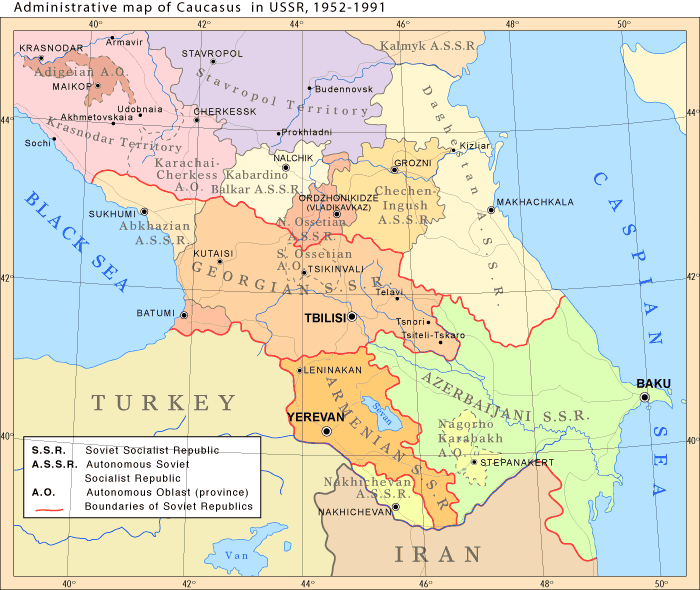- South Caucasus
thumb|250px|Administrative_map_of_Caucasus inUSSR , 1952-1991.] The South Caucasus is a mountainous, geopolitical area of south-centralEurasia , also referred to as Transcaucasia, or "The Transcaucasus". More specifically, the South Caucasus area spans the southern portion of theCaucasus Mountains and its lowlands, lying between the two continents ofEurope andAsia and extending from the southern part of theGreater Caucasus Mountain range of southwesternRussia and going southerly to the Turkish andArmen ian borders, travelling between the Black andCaspian Sea s. The area includes the southern part of the Greater Caucasus Mountain range, the entire Lesser Caucusus Mountain range, theColchis Lowland s andKura-Aras Lowland s, theTalysh Mountains , theLenkoran Lowland s, and theJavakheti-Armenian Uplands . "The Transcaucasus", or South Caucasus area, is a part of the entire Caucasus geographical region that essentially divides theEurasia n transcontinent into two.All of
Armenia is in Transcaucasia; the majority of Georgia andAzerbaijan , including the exclave of Naxçivan, fall within this area. The countries of the region are producers of oil, manganese ore,tea ,citrus fruits , andwine .In Western languages, the terms "Transcaucasus" and "Transcaucasia" are translations of the Russian "zakavkazie" meaning "the area beyond the Caucasus Mountains", i.e., as seen from the Russian capital (analogous to the Roman terms Transalpine and Transpadania). The region remains one of the most complicated in the post-Soviet area, and comprises three heavily disputed areas –
Abkhazia andSouth Ossetia in Georgia, andNagorno-Karabakh inAzerbaijan .History
Located on the peripheries of
Armenia ,Turkey , andRussia , the region has been an arena for political, military, religious, and cultural rivalries and expansionism for centuries. Throughout its history, the Caucasus was usually incorporated into the Iranian world. At the beginning of the 19th century, theRussian Empire conquered the territory from theQajars . [ [http://www.iranica.com/newsite/articles/v5f1/v5f1a032.html Thorez, Pierre. "Caucasus." "Encyclopaedia Iranica". June 2, 2007] ]Ancient kingdoms of the region included
Armenia , Albania, and Iberia, among others. These kingdoms were later incorporated into various empires, including Media,Achaemenid Empire ,Parthian Empire , andSassanid Empire . By this time,Zoroastrianism had become the dominant religion of the region; however, the region would go through two other religious transformations. Owing to the rivalry between Persia and Rome, and later Byzantium, the latter would invade the region several times, although never being able to hold it. However, because Armenia had become a Christian entity, Christianity began to overtake Zoroastrianism. With theIslamic conquest of Persia , the region came under the rule of theArabs and Islam spread throughout the region. The region would later be conquered by theSeljuks ,Mongols , local kingdoms and khanates, as well as, once again, Persia, until its conquest by Russia.The region was unified as a single political entity twice – during the
Russian Civil War (Transcaucasian Democratic Federative Republic ) from9 April 1918 to26 May 1918 , and under the Soviet rule (Transcaucasian SFSR ) from12 March 1922 to5 December 1936 .The area of Transcaucasia, in particular where modern day Georgia and Armenia are located, is one of the native areas of the wine producing vines "
vitis vinifera ". Some experts speculate that this may be the birthplace of wine production. [ Hugh Johnson "Vintage: The Story of Wine" pg 15 Simon & Schuster 1989 ] Archeological excavation and carbon dating ofgrape pips from the area have dated back to 7000-5000BC. [ Ibid. pg 17 ]See also
*
Caucasus
*North Caucasus (Ciscaucasia)
*Ibero-Caucasian languages
*Peoples of the Caucasus Footnotes
ources and references
(incomplete)
* [http://www.bartleby.com/65/tr/Transcau.html Transcaucasia (The Columbia Encyclopedia article)]External links
* [http://www.cria-online.org Caucasian Review of International Affairs - an academic journal on the South Caucasus]
Wikimedia Foundation. 2010.

